Ready to take your content to the next level? Explore the endless possibilities of best content syndication platforms for unparalleled reach and impact.
In the fast-paced realm of digital marketing, the relentless competition for audience engagement can hinder even the most compelling content from reaching its intended audience. Content syndication emerges as a potent tool in this ongoing battle, presenting a strategic approach to expand the reach of your content and attract valuable traffic. This in-depth blog explores the leading content syndication platforms, examining their distinct features, target audiences, and pricing structures. By offering a thorough analysis of these platforms, this blog empowers you to surpass the constraints of organic reach and make well-informed decisions. Ultimately, this knowledge enables you to choose the platform that best aligns with your unique content strategy, propelling your marketing objectives to new levels of success.
What is a content syndication ?
Content syndication is a marketing strategy where you strategically republish your existing content (articles, videos, etc.) on other websites or platforms. This expands your reach beyond your own space, connecting you with new audiences who might not have found your content otherwise. While it’s not just copying and pasting everywhere, effective syndication involves choosing relevant platforms, tailoring content if needed, and following best practices to avoid search engine penalties.
What is the goal of content syndication?
Content syndication is a powerful tool for maximizing the impact of your content. Primary goals of content syndications are achieving brand awareness, website traffic, and lead generation.
Types of Content Syndication
Content syndication comes in various types, catering to different budgets and marketing goals. Here’s a quick overview of the three main types:
Free: This approach involves leveraging existing platforms and resources to share your content at no cost.
- Self-service syndication: Platforms like Medium or LinkedIn allow publishing your content directly, reaching their audiences and potentially getting picked up by other publications.
- Guest blogging: Contributing content to relevant websites in your niche exposes your brand and expertise to a new audience, often with backlinks to your own site.
- Social media promotion: Sharing your content organically or through paid social media advertising can drive traffic from your followers and their connections.
Paid: This strategy involves paying for services or advertising to amplify your content’s reach and visibility.
- Content distribution platforms: Platforms like Outbrain or Taboola promote your content to relevant audiences across various websites, increasing its visibility and driving targeted traffic.
- Influencer marketing: Partnering with established figures in your niche can leverage their audience and credibility to promote your content.
- Sponsored content: Paying publications to feature your content within their existing content, reaching their established audience and potentially gaining valuable backlinks.
Owned: This focuses on maximizing the reach of your content through your own channels and platforms.
- Blog: Publishing high-quality content on your own blog attracts a dedicated audience and establishes your brand expertise.
- Email marketing: Promoting your content to your existing email subscribers fosters engagement and drives targeted traffic.
- Social media communities: Building and engaging with communities around your brand on social media platforms fosters organic reach and content visibility.
Choosing the right type of syndication depends on your budget, marketing goals, and target audience. Combining free, paid, and owned strategies can create a well-rounded content syndication plan for maximum impact.
Top 15 Content Syndication Platforms
Medium
Overview: Medium is a popular online publishing & content syndication platform that allows users to write, share, and interact with articles on various topics. It is known for its user-friendly interface and diverse range of content.
Monthly Traffic: 45.7 M
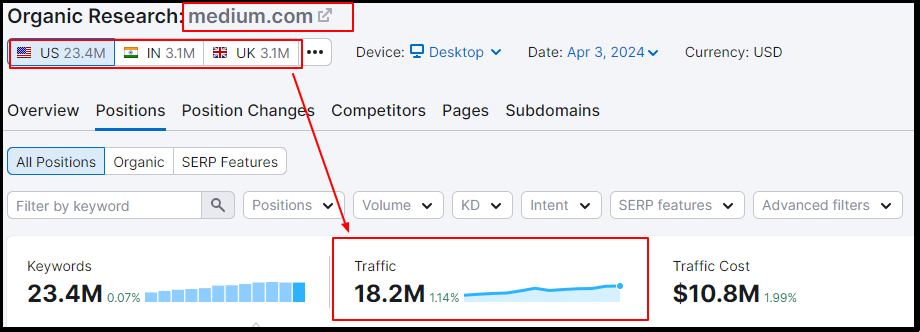
Features
- Easy-to-use editor for writing and formatting articles.
- Ability to follow other users and publications.
- Medium Partner Program for monetizing content.
- Curation of articles based on user interests.
Audience: Medium attracts a wide audience interested in reading and writing high-quality articles across different genres. It is popular among writers, bloggers, professionals, and readers seeking informative content.
Pros
- Simple and intuitive platform for publishing.
- Opportunity to earn money through the Partner Program.
- Engaged community of readers and writers.
Cons
- Limited customization options for personalizing profiles.
- Changes in the Partner Program policies have affected some writers’ earnings.
Substack
Overview: Substack is an email newsletter content syndication platform that enables writers to create subscription-based newsletters. It provides tools for writers to build their audience and monetize their content through subscriptions.
Monthly Traffic: 2.9 M
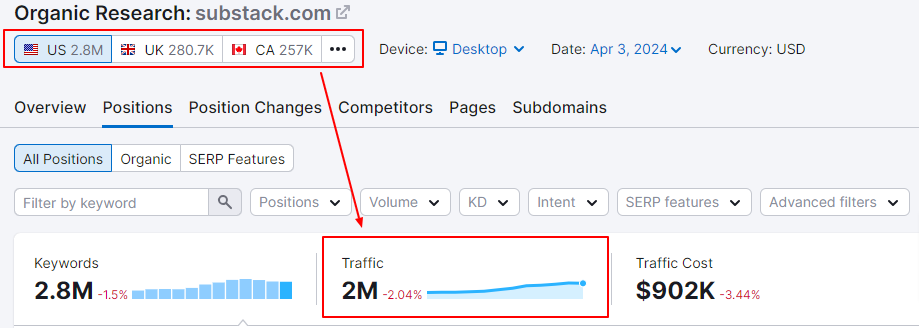
Features
- Easy setup for creating newsletters.
- Subscription model for monetization.
- Analytics to track subscriber engagement.
- Integration with social media platforms.
Audience: Substack caters to writers, journalists, bloggers, and content creators looking to connect directly with their audience through personalized newsletters. It appeals to those seeking independent publishing opportunities.
Pros
- Straightforward platform for launching newsletters.
- Direct relationship with subscribers.
- Potential for earning revenue through subscriptions.
Cons
- Limited design customization options for newsletters.
- Reliance on subscriber numbers for revenue generation.
Slideshare
Overview: Slideshare is a platform for sharing presentations and slideshows online. It allows users to upload, view, and share slide decks on various topics, making it a valuable resource for educational and professional purposes.
Monthly Traffic: 18.3 M
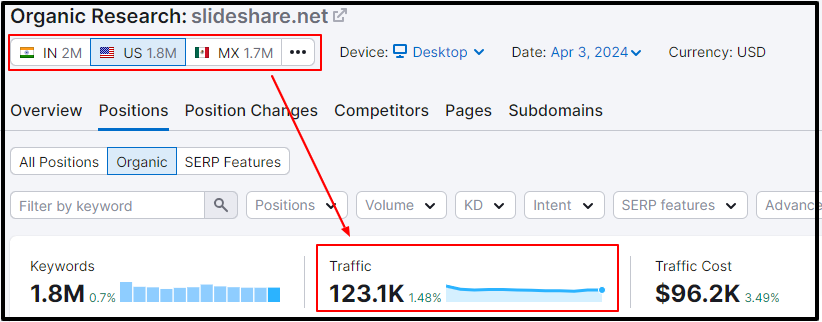
Features
- Ability to upload and organize presentations.
- Embedding slideshows on websites.
- Analytics to track views and engagement.
- Social sharing options.
Audience: Slideshare caters to professionals, educators, students, and businesses looking to share visual content such as presentations, infographics, and documents. It is widely used for knowledge sharing and marketing purposes.
Pros
- Wide reach for content dissemination.
- Integration with social media platforms.
- Analytics tools for monitoring performance.
Cons
- Limited interactivity compared to other presentation platforms.
- Some features may require a premium subscription.
Quora
Overview: Quora is a question-and-answer & content syndication platform where users can ask questions, answer queries, and engage in discussions on various topics. It serves as a knowledge-sharing community with a vast range of subjects covered.
Monthly Traffic: 358.2 M
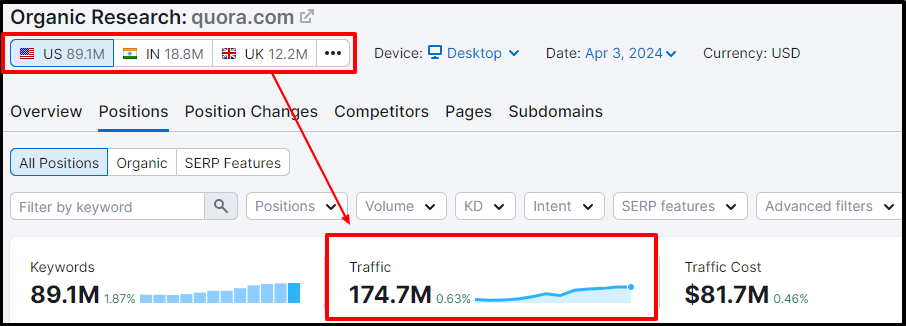
Features
- Asking and answering questions.
- Upvoting answers based on quality.
- Following topics and users.
- Quora Spaces for group discussions.
Audience: Quora attracts a diverse audience seeking information, advice, and opinions on a wide array of topics. It is popular among professionals, students, researchers, and individuals looking to share knowledge.
Pros
- Access to expertise from diverse fields.
- Networking opportunities with professionals.
- Quality content moderation.
Cons
- Potential for misinformation due to user-generated content.
- Some users may experience spam or irrelevant answers.
Outbrain
Overview: Outbrain is a content syndication platform that helps publishers and advertisers reach a wider audience by recommending articles, videos, and other content on various websites. It focuses on personalized content recommendations to engage users.
Monthly Traffic: 122.1 K
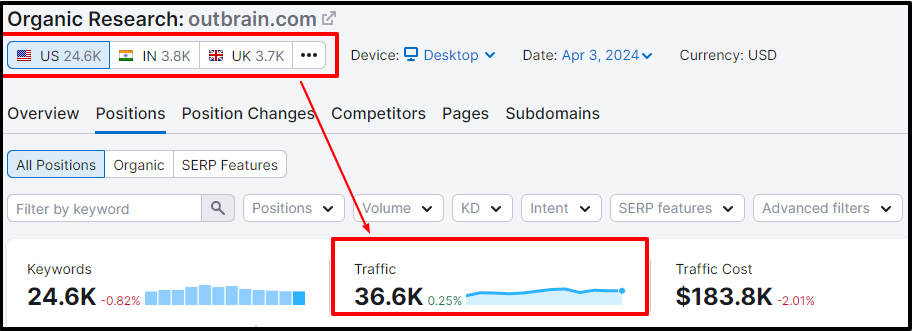
Features
- Content recommendation widgets.
- Targeted advertising options.
- Analytics for tracking engagement.
- Native ad placements.
Audience: Outbrain content syndication caters to publishers, advertisers, and marketers looking to increase their content visibility and drive traffic to their websites. It is used by businesses seeking to promote their content effectively.
Pros
- Broad reach across different content syndication websites.
- Personalized content recommendations.
- Tools for optimizing ad campaigns.
Cons
- Some users may find the promoted content intrusive.
- Ad performance can vary based on targeting strategies.
Taboola
Overview: Taboola is a content discovery and native advertising platform that helps publishers and advertisers promote their content across various digital channels. It focuses on engaging users with personalized recommendations.
Monthly Traffic: 103.7 K
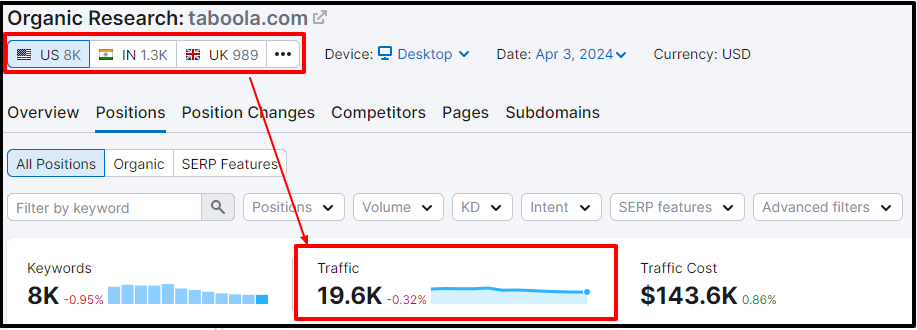
Features
- Content recommendation widgets.
- Sponsored content placements.
- Audience targeting options.
- Performance analytics.
Audience: Taboola serves publishers, advertisers, and marketers aiming to enhance their content distribution and advertising strategies. It is popular among businesses looking to increase brand visibility.
Pros
- Extensive network of publishers and websites.
- Targeted advertising capabilities.
- Data-driven insights for campaign optimization.
Cons
- Some users may perceive the promoted content as intrusive.
- Ad performance can be influenced by various factors like audience targeting.
Scoop.it
Overview: Scoop.it is a interactive content syndication platform that allows users to discover, curate, and share content on various topics. It enables individuals and businesses to create curated content collections for online sharing.
Monthly Traffic: 134.9 K
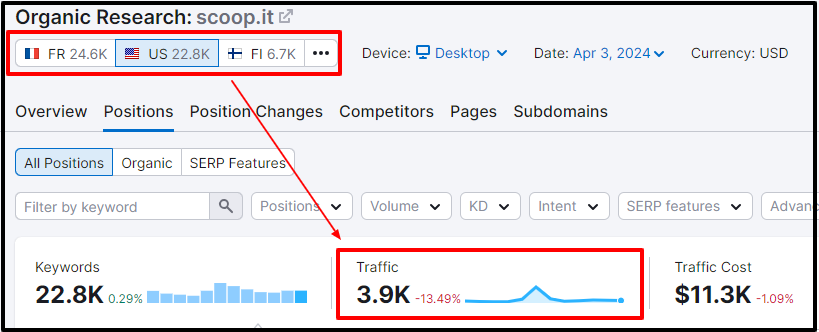
Features
- Content discovery tools.
- Customizable content curation.
- Social media integration.
- Analytics for tracking content performance.
Audience: Scoop.it caters to content creators, marketers, bloggers, and businesses looking to curate and share relevant content with their audience. It is popular among professionals seeking to establish thought leadership.
Pros
- Easy-to-use platform for content curation.
- Social media integration for seamless sharing.
- Analytics tools for monitoring content engagement.
Cons
- Limited customization options for free accounts.
- Some users may find the pricing plans restrictive.
Tumblr
Overview: Tumblr is a microblogging platform and social networking site that allows users to post multimedia content in the form of blogs, images, videos, and more. It emphasizes creative expression and community interaction.
Monthly Traffic: 15.8 M

Features
- Blogging tools for multimedia posts.
- Social networking features like reblogging and likes.
- Customizable themes for personalizing blogs.
- Mobile app for on-the-go posting.
Audience: Tumblr attracts a diverse audience of artists, bloggers, photographers, and creatives looking to share their work and connect with like-minded individuals. It is known for its vibrant community and niche content.
Pros
- Creative platform for multimedia expression.
- Strong sense of community engagement.
- Mobile-friendly interface for easy posting.
Cons
- Limited analytics tools for tracking blog performance.
- Changes in policies affecting certain types of content.
Overview: LinkedIn is a professional networking platform designed for career development, networking, and business connections. It allows users to create professional profiles, connect with others, and engage in industry discussions.
Monthly Traffic: 732.6 M
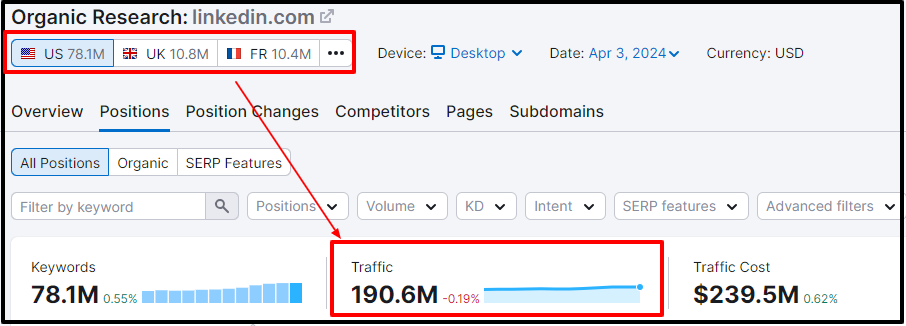
Features
- Profile creation for showcasing professional experience.
- Networking through connections and groups.
- Job search and recruitment features.
- Content sharing and publishing tools.
Audience: LinkedIn caters to professionals, job seekers, recruiters, businesses, and industry experts looking to network, recruit talent, share insights, and build their personal brand. It is widely used for professional networking purposes.
Pros
- Networking opportunities with industry professionals.
- Job search and recruitment functionalities.
- Platform for sharing industry insights and thought leadership.
Cons
- Some users may find the interface overwhelming.
- Limited organic reach for shared content.
Overview: Reddit is a social news aggregation and discussion platform where users submit and vote on content across various topics. It serves as a hub for niche communities and discussions on various subjects.
Monthly Traffic: 429 M
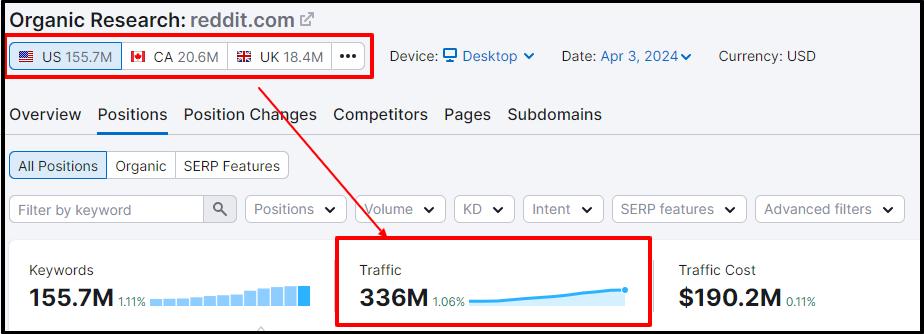
Features:
- Content submission and voting system.
- Subreddits for niche discussions.
- User-generated content and discussion threads.
- Moderation tools for community management.
Audience: Reddit caters to a diverse audience of users seeking information, entertainment, and community engagement across various topics. It is popular among individuals looking to participate in discussions and share content.
Pros
- Wide range of niche communities.
- User-generated content and discussions.
- Moderation tools for community management.
Cons
- Potential for misinformation due to user-generated content.
- Some users may experience negative interactions in certain communities.
Overview: Flipboard is a content syndication platform that allows users to discover, collect, and share articles, videos, and other content across various topics. It provides a personalized and visually appealing interface for content exploration.
Monthly Traffic: 64.4 K
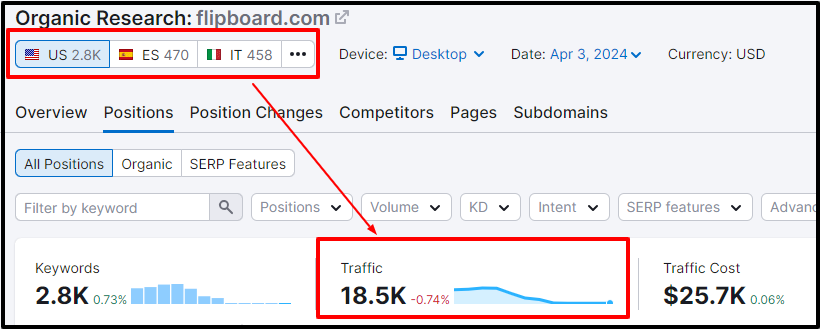
Features
- Content discovery, curation and content syndication tools.
- Personalized magazine creation.
- Social sharing options.
- Integration with other platforms like Twitter and Facebook.
Audience: Flipboard caters to users seeking to discover and share content across various topics. It is popular among individuals looking for a personalized and visually appealing way to explore content.
Pros
- Personalized content recommendations.
- Social sharing options for easy distribution.
- Integration with other platforms for seamless content sharing.
Cons
- Limited customization options for personalization.
- Content availability may vary based on user interests.
Zemanta
Overview: Zemanta is a content discovery and recommendation platform that helps publishers and advertisers distribute their content across various content syndication channels. It focuses on personalized content recommendations to engage users.
Features
- Content recommendation widgets.
- Targeted advertising options.
- Analytics for tracking engagement.
- Native ad placements.
Monthly Traffic: 1.7 K
Audience: Zemanta serves publishers, advertisers, and marketers looking to increase their content visibility and drive traffic to their websites. It is used by businesses seeking to promote their content effectively.
Pros
- Broad reach across different websites.
- Personalized content recommendations.
- Tools for optimizing ad campaigns.
Cons
- Some users may find the promoted content intrusive.
- Ad performance can vary based on targeting strategies.
ITmunch
Overview: ITmunch is a content marketing platform that helps businesses create, distribute, and measure the impact of their content across various digital channels. It provides tools for content creation, optimization, and analytics.
Features
- Content creation tools.
- Distribution and promotion options.
- Analytics for tracking content performance.
- Integration with other marketing tools.
Audience: ITmunch caters to businesses, marketers, and content creators looking to develop and distribute high-quality content to engage their audience and drive business growth.
Pros
- Comprehensive content marketing platform.
- Integration with other marketing tools.
- Analytics for measuring content performance.
Cons
- Some users may find the pricing plans restrictive.
- Limited customization options for free accounts.
ContentMX
Overview: ContentMX is a content marketing platform that provides tools for creating, distributing, and measuring the impact of content across various digital channels. It offers a range of features for content creation, optimization, and analytics.
Features
- Content creation tools.
- Distribution and promotion options.
- Analytics for tracking content performance.
- Integration with other marketing tools.
Audience: ContentMX caters to businesses, marketers, and content creators looking to develop and distribute high-quality content to engage their audience and drive business growth.
Pros
- Comprehensive content marketing platform.
- Integration with other marketing tools.
- Analytics for measuring content performance.
Cons
- Some users may find the pricing plans restrictive.
- Limited customization options for free accounts.
TripleLift
Overview: TripleLift is a content discovery and recommendation platform that helps publishers and advertisers distribute their content across various digital channels. It focuses on personalized content recommendations to engage users.
Features
- Content recommendation widgets.
- Targeted advertising options.
- Analytics for tracking engagement.
- Native ad placements.
Audience: TripleLift serves publishers, advertisers, and marketers looking to increase their content visibility and drive traffic to their websites. It is used by businesses seeking to promote their content effectively.
Pros
- Broad reach across different websites.
- Personalized content recommendations.
- Tools for optimizing ad campaigns.
Cons
- Some users may find the promoted content intrusive.
- Ad performance can vary based on targeting strategies.
Is content syndication good for SEO?
The relationship between syndicated content and SEO is a complex one. Syndicated content involves republishing existing content on other websites to reach a wider audience. While syndicated content can be beneficial for increasing exposure and driving organic traffic back to a website, there are SEO risks involved due to potential issues like content duplication and the risk of outranking original content. Google advises syndicating carefully and ensuring that each site includes a link back to the original article.
When it comes to syndicating content, it’s crucial to use canonical tags to indicate the original source of the content and resolve any duplicate content issues. Additionally, including internal links within syndicated articles can pass authority and equity through to these links, benefiting SEO performance by broadening the backlink profile and providing search engines with more context about the content’s relevancy and popularity.
To successfully syndicate content, it’s essential to carefully select publications, pitch content effectively, build partnerships, and consider whether free or paid syndication methods are more suitable for your goals. By following best practices, such as using canonical links, discussing references with editors, and including internal links, syndicated content can be a valuable tool for enhancing SEO performance when done thoughtfully and strategically.
Conclusion
Content syndication can be a valuable tool in your B2B marketing toolbox, but it’s not a one-size-fits-all solution. Maximize its potential by sharing valuable content on relevant, high-quality content syndication platforms. This expands your reach, builds brand awareness, and positions you as a thought leader within the industry. Remember, syndication complements, not replaces, your core content strategy. Continue creating high-quality content for your website to nurture leads and keep them engaged. When done right, syndication can be a powerful way to reach new audiences and drive valuable leads.





